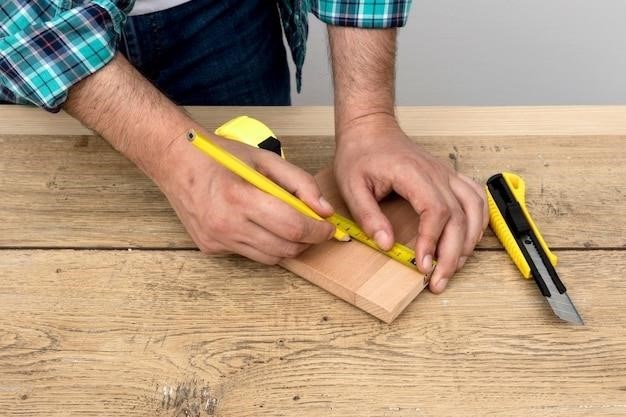
Hacksaw Guide⁚ A Comprehensive Overview
A hacksaw guide is a specialized tool designed to provide precise and controlled cuts when using a hacksaw. It is particularly useful for cutting round tubing, such as bicycle handlebars, seatposts, and steering columns, ensuring straight and clean cuts. Hacksaw guides typically clamp onto the material being cut, guiding the hacksaw blade along a predetermined path, minimizing the risk of damage or injury.
Introduction
A hacksaw guide is an indispensable tool for anyone who needs to make precise and controlled cuts with a hacksaw. It is a specialized tool designed to ensure straight, clean cuts, especially when working with round tubing, such as bicycle handlebars, seatposts, and steering columns. This guide effectively minimizes the risk of damage or injury by providing a stable and controlled platform for the hacksaw blade.
The use of a hacksaw guide is particularly beneficial for those involved in bicycle maintenance, metalworking, and DIY projects. It allows for accurate cuts without the need for complex jigs or specialized equipment. The guide also helps to prevent the hacksaw blade from slipping or wandering, ensuring a clean and professional finish.
In essence, a hacksaw guide is an essential tool for anyone who needs to make precise cuts with a hacksaw, ensuring a safe and efficient cutting experience.
Types of Hacksaws
While hacksaw guides are primarily used with traditional hacksaws, the types of hacksaws themselves can vary depending on their intended use and features. Here are some common types of hacksaws⁚
- Adjustable Hacksaws⁚ These hacksaws feature a frame that can be adjusted to accommodate different blade lengths. They offer flexibility for cutting various materials and sizes.
- Compact Hacksaws⁚ These hacksaws are designed for portability and ease of use, making them ideal for small jobs or working in confined spaces.
- Junior Hacksaws⁚ These hacksaws are smaller and lighter than standard hacksaws, designed for lighter-duty tasks and cutting smaller materials.
- Heavy-Duty Hacksaws⁚ These hacksaws are built for cutting through thick and tough materials, often featuring reinforced frames and durable blades.
- Close-Quarters Hacksaws⁚ These hacksaws have a unique design that allows for cutting in tight spaces, where a standard hacksaw would not fit.
The type of hacksaw you choose will depend on the specific tasks you need to perform.
Choosing the Right Hacksaw Blade
Selecting the appropriate hacksaw blade is crucial for achieving clean, efficient cuts with your hacksaw guide. The choice of blade depends on the material you’re cutting and the desired finish. Here are some factors to consider⁚
- Material Hardness⁚ For hard plastics and soft metals, carbon steel blades are often suitable. However, for harder metals, bimetal or high-speed steel blades provide greater durability and cutting performance.
- Tooth Size and Shape⁚ The tooth size, also known as the “pitch,” determines the number of teeth per inch. Fine-toothed blades are better for precise cuts and smoother finishes, while coarse-toothed blades are more effective for cutting thicker or tougher materials. The shape of the teeth can also influence the cutting action.
- Blade Thickness⁚ The blade thickness impacts the strength and rigidity of the blade. Thicker blades are generally more durable but may require more force to cut.
- Blade Length⁚ Choose a blade length that is appropriate for the size of the material you are cutting. Longer blades are useful for cutting large pieces, while shorter blades are more manageable for smaller tasks.
Always refer to the blade manufacturer’s recommendations for the appropriate blade type for your specific application.
Hacksaw Guide⁚ An Essential Tool
A hacksaw guide is an indispensable tool for anyone who needs to make precise, straight cuts on round tubing. It eliminates the guesswork and potential for errors that come with freehand cutting, ensuring clean and consistent results. This is particularly crucial when working on delicate or critical components, such as bicycle frames, handlebars, or steering columns.
Beyond its accuracy, a hacksaw guide also significantly enhances the safety of the cutting process. By guiding the hacksaw blade along a predetermined path, it minimizes the risk of the blade slipping and causing injury. This is especially important when working with sharp, hardened materials like metal.
Furthermore, a hacksaw guide can significantly reduce the physical effort required for cutting. It provides a stable platform for the blade, allowing for smoother and more controlled sawing, making the task easier and more efficient.
Using a Hacksaw Guide Effectively
To maximize the benefits of a hacksaw guide, it’s essential to use it correctly. Begin by selecting the appropriate hacksaw blade for the material you’re cutting; A fine-tooth blade is ideal for thin-walled tubing, while a coarse-tooth blade is better suited for thicker materials. Ensure the blade is securely mounted in the hacksaw frame and properly tensioned.

Next, clamp the hacksaw guide onto the tubing, ensuring a secure and snug fit. The guide should be positioned precisely where you want the cut to be made. Use a marker to mark the cutting line on the tubing for added accuracy. Start the cut slowly and steadily, applying consistent pressure to the hacksaw handle.
Maintain a straight sawing motion, allowing the guide to direct the blade. As you cut, avoid applying excessive pressure, which can cause the blade to bend or break. Periodically check the cutting progress to ensure the blade is staying on track. Once you’ve reached the desired depth, carefully remove the guide and complete the cut.
Safety Precautions When Using a Hacksaw
While hacksaws are versatile tools, it’s crucial to prioritize safety when using them. Always wear safety glasses to protect your eyes from flying debris. A pair of work gloves will provide a secure grip on the hacksaw handle and protect your hands from cuts or scratches.
Ensure that the work area is well-lit and free of clutter. Securely clamp the material you are cutting to a workbench or vise to prevent it from moving during the cutting process. This helps maintain stability and control, minimizing the risk of accidents.
Maintain a firm grip on the hacksaw handle and avoid excessive force. Applying too much pressure can cause the blade to break or bend, potentially leading to injury. Always use a hacksaw guide when cutting round tubing to ensure a clean and straight cut while minimizing the risk of slipping or losing control.
Common Hacksaw Guide Applications
Hacksaw guides find widespread applications in various fields, particularly in metalworking and bike maintenance. In bicycle repair, they are indispensable for accurately cutting handlebars, seatposts, and steering columns to achieve the desired length. They ensure clean, straight cuts, preventing any damage to the delicate tubing.
Beyond bicycles, hacksaw guides are also valuable in plumbing and metal fabrication. They are used to cut pipes, tubing, and other metal sections for various projects, ensuring precision and avoiding the risk of uneven or crooked cuts. Their versatility extends to DIY projects where precise cutting of metal materials is required, such as building custom metal structures or modifying existing metal components.
Their use in metalworking extends to professional workshops and fabrication shops. They are essential for cutting metal rods, bars, and sheets to specific dimensions, ensuring precise and clean cuts crucial for various applications.
Maintaining Your Hacksaw Guide
Proper maintenance ensures your hacksaw guide continues to deliver accurate and efficient cuts. Regular cleaning is crucial to prevent debris buildup that can hinder smooth operation. Use a soft brush or cloth to remove sawdust, metal shavings, and other particles from the guide’s surfaces, especially the clamping mechanism and the guiding track.
Lubrication plays a vital role in maintaining the guide’s functionality. Apply a light coating of oil or grease to the moving parts, such as the clamping mechanism and the guide track, to reduce friction and wear. This ensures smooth operation and prevents rust or corrosion. Always check the clamping mechanism for any signs of wear or damage. If necessary, replace worn-out parts to maintain proper clamping force.
Storage is also important. After each use, clean the guide thoroughly and store it in a dry and dust-free environment. This prevents rust and corrosion, extending the life of the tool.
Popular Hacksaw Guide Brands
Several reputable brands offer high-quality hacksaw guides, catering to various needs and applications. Park Tool, a well-known name in the cycling industry, is a popular choice for bicycle maintenance, with their SG-6 Threadless Saw Guide being a widely recognized option. IceToolz, another prominent brand in the cycling tool market, offers a range of hacksaw guides for different tube sizes, ensuring precise cuts for various applications.
PRO, a brand known for its quality cycling components and tools, also produces hacksaw guides designed for handlebars and head tubes, offering durability and accuracy. Other reputable brands include pRO and Bikeinn, each offering a selection of hacksaw guides with varying features and specifications. When choosing a brand, consider the specific application, the material you’ll be cutting, and the desired level of precision and durability.
A hacksaw guide is an invaluable tool for anyone who needs to make precise and controlled cuts on round tubing. It simplifies the process, ensuring straight and clean cuts while minimizing the risk of damage or injury. From bicycle maintenance to various DIY projects, a hacksaw guide can be a valuable addition to your toolkit. When selecting a hacksaw guide, consider your specific needs, the material you will be cutting, and the level of precision required.
With the right hacksaw guide, you can confidently tackle a variety of cutting tasks, achieving professional-looking results. Remember to always prioritize safety and follow the manufacturer’s instructions for proper use and maintenance of your hacksaw guide.




